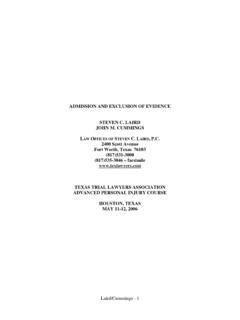Transcription of BOOK OF REVELATION STUDY GUIDE - taylorstudies.com
1 book OF REVELATION STUDY GUIDE Glenn Taylor I. Both testaments can be divided into History Instruction Prophecy REVELATION is the only book of prophecy in the New Testament. Very important we note this and realize we cannot STUDY REVELATION in the same way we STUDY the book of Romans. II. Note the following keys to the book Key Word overcome Nikao victory or conquer 2:7, 11, etc., 17: 14 Key Verses 1:1, 1: 19, 2: 10, 22: 18 19 Key Phrase Blessed are those who do HIS commandments 22: 14 Theme Victory in Jesus, 11: 15, 17: 14 To whom was it written? To the 7 churches and anyone who has an ear (1: 4; 2: 7) III. 2 Categories of Language Literal or Figurative IV. Apocalypse Greek word for REVELATION is Apokalupsis from which we get Apocalypse. The meaning is an unveiling or uncovering.
2 The style of writing in REVELATION is figurative and is known as apocalyptic literature. There are some characteristics of the apocalyptic style of writing: 1. Grows out of some great conflict 2. Visions 3. Has a predictive element 4. Symbolic language 5. Drama 2 V. Why use the apocalyptic (figurative, prophetic) style of writing? 1. John is explaining visions in terms they could understand 2. To obscure the message from the enemy 3. To evoke certain emotions VI. 3 Principles that will help us 1. We can understand the book even though we might not understand every sign/symbol. 2. The book is presented in the form of a great drama. 3. Perhaps the most important thing is for us to determine the original meaning the book would have had to the recipients. VII. Some critical background STUDY 1.
3 Bible Geography 2. AUTHOR Jesus Christ to John (1: 1) Which John? Most of the evidence points to the Apostle John 3. Recipients Originally to the 7 churches of Asia, ESP TSP L, (1: 4) Also intended for all (1: 3, 2: 7, etc) 4. Date There are 2 dates generally suggested AD 68 prior to fall of Jerusalem AD 96 most widely accepted and the one we will use 5. Theme Noted earlier 6. Purpose see following page for thorough discussion 3 VIII. The Purpose Why was REVELATION written? To understand this we must have some understanding of the historical events of the time. The short answer to the question is To encourage the church during a period of Roman persecution and tribulation. The message was to remain faithful and not give up. Biblical Historical Setting AD 53 Paul used Ephesus as a center in Asia see Acts 19: 10 AD 60-62 Paul wrote the prison epistles of Ephesians, Colossians, Philippians, and Philemon AD 70-95 John spent much time in Ephesus and the province of Asia.
4 Secular Historical Setting - Emperor Worship Julius Caesar - date 45 BC statue with inscription to the invincible god Augustus Caesar 27 BC to AD 14 1st Emperor of Rome called himself the son of god Caligula, Nero, and Domitian 3 of 1st Century Emperors of note in discussion of Emperor worship Asia Minor was a hot bed for emperor worship. World Conditions On the Plus side - Roman Empire ruled the world many advantages language, roads, peace On the Negative side The Emperors assumed the role of deity. Christians were put to the ultimate test. Often had to have papers or a mark to signify they had worshipped the emperor. Note the early persecution was from the Jews. Later the persecution was from the Romans. When the Romans finally realized Christianity was not Judaism, then it became illegal.
5 From Foxes Christian Martyrs 1st Persecution Nero AD 64 67 2nd Persecution Domitian AD 81 - 96 3rd Persecution Trajan AD 98 117 See Halley s Bible Handbook pg 761 ff 4 IX. The Significance of Colors and Numbers (Adapted from Bill Wheeler material) Numbers 1 Unity, togetherness (One GOD) 2 Confirmation, strength (two witnesses) 3 Divine completeness, a sacred number, sometimes repeated 3 times for emphasis ( Father, Son and Holy Ghost) 4 Earthly, completeness in nature, 4 corners of earth, 4 directions, etc 5 5 and multiples (5, 10, 50,etc) signify human completeness (5 fingers) 6 1 short of 7 implies imperfection, failure, sometimes even evil (666?) 7 Perfection, completeness, inclusiveness 10 Again completeness from a human standpoint (10 fingers) Multiples (100, 1000) - Perfection, fullness or long indefinite period of time 12 4 (earthly) multiplied times 3 (Divine) is symbolic in religion 12 tribes, 12 apostles, 12 gates 12 is a perfect number in Hebrew numerology 12 times 12 times 1000 = 144,000 symbolic of the people of GOD 3 7 cut in half thus incompleteness or imperfection 1250 days = 3 years 42 months = 3 years Colors White purity, righteousness, innocence Black distress, calamity Red war, bloodshed Pale famine, death Purple pomp, luxury, royalty Scarlett color of blood thus persecution, suffering, cruelty 5 X.
6 Some Key Words (Adapted from Wayne Jackson s STUDY of REVELATION material) Almighty Gk pantokrator pan = all, krateo = to hold. 9 of 10 uses are in REVELATION (2 Cor 6: 18). As early Christians faced death for the cause of Christ they needed to know GOD was in control. Throne Gk thronos dignity, power, authority. of the uses are found in REVELATION . On earth it sometimes appears that Satan occupies the throne but Deity still rules in spite of the temporary victories for evil. Crown 1. Gk stephanos the victory crown see 2: 10 2. Gk diadem the crown of royalty see 12: 3, 13: 1, 19: 12 the first 2 Satan claims authority but Christ will triumph. Lamb 1. Gk amnos Lamb for sacrifice this term used in NT but not once in REVELATION .
7 2. Gk arnion REVELATION term is Lamb which lives and is not marked for sacrifice (Jn 21: 15) Beasts - 1. Gk zoon merely denotes a living creature 4: 8, 9 inappropriate to render beast in view of our present day connotation hence the modern translations use of living creature. 2. Gk therion a wild beast many scholars believe these beasts are symbolic of pagan Rome and later papal Rome see mark of the beast. Horses Gk hippos almost always used as an instrument of war. In REVELATION the horse is a symbol of the hostile, persecuting forces against Christianity. Forever and Ever Gk eis for, aion age, eternity. Sometimes used in OT as a limited period of time (Exo 12: 14). But always used in NT to denote that which is unending 1: 18, 4: 10 , etc.
8 Must shortly take place Gk en tachei does not mean at once or shortly but rather with speed, swiftness or quickly. Not all of REVELATION would happen in the near future but it would start quickly. As a matter of fact some of the things were already happening, see chapters 2-3. En tahei is used twice in REVELATION (1: 1, 22: 6). The latter reference is talking about the 2nd coming which clearly shows that event did not happen soon but it will happen with suddenness in the future. 6 XI. Approaches to the book (Sections XI and XII adapted from Alan Highers material) 1. Preterist The term preterist means that which has gone by. The word preterist (past) is used in different ways, but here we use it to refer to one who believes the book of REVELATION was written before 70 and that it was fulfilled in the destruction of Jerusalem and the fall of the Jewish state.
9 2. Futurist Futurist is just the opposite of preterist. The preterist believes nearly all of REVELATION has been fulfilled. The futurist believes that nearly all of REVELATION is yet future, especially chapters 4 22. Many futurists believe in an earthly millennial reign to be established when Christ comes again. We call these premillenialists pre (before) and millennium (1000). 3. Historical This method views the book of REVELATION as a blueprint of history, , it lays out the history of the church in symbolic form. According to this approach, much of the book deals with the apostasy of the Roman Catholic Church, followed by the Reformation and the Restoration. Many of the older brethren, and older commentaries, took this view. John T. Hinds who wrote the Gospel Advocate commentary on REVELATION held this view.
10 4. Idealistic The idealistic or philosophy of history method looks upon REVELATION as a symbolic conflict between right and wrong. This approach to the book does not find any specific application of the signs and symbols. It sees the book as a representation of the age-old battle between good and evil and is unrelated to specific historical events. 5. Contextual The contextual view holds that REVELATION grew out of the context of its own time and circumstances. The churches of Asia were suffering persecution and hardship. The Roman government was powerful and cruel. Some wondered if they could remain faithful. The book of REVELATION was written to address this need. The author endeavors to encourage the persecuted saints of his own day and, by application, the church throughout the ages.






